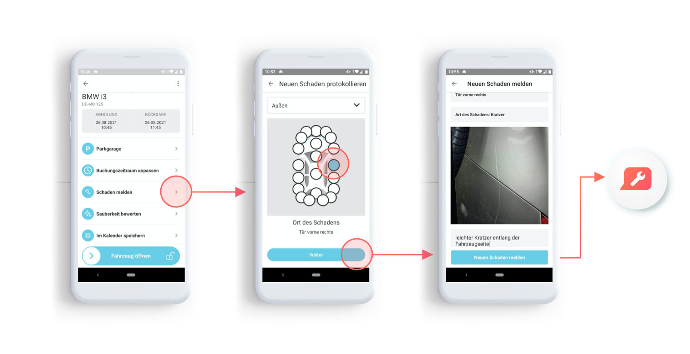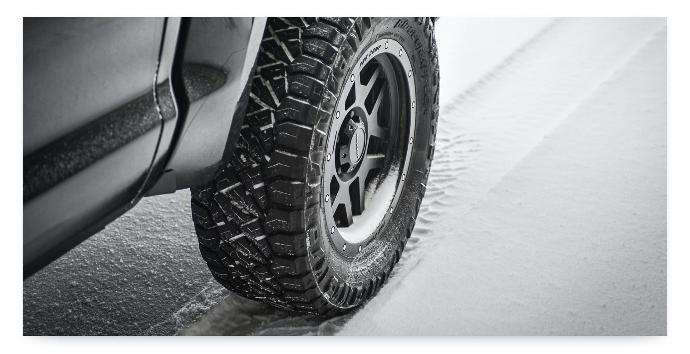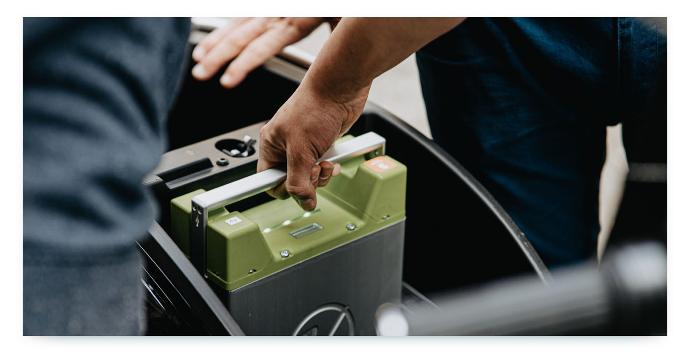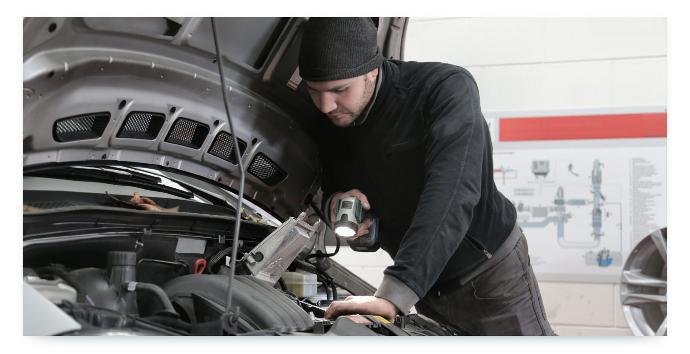Attractive and running vehicles are one of the biggest guarantors of user satisfaction. They lay the foundation for your success and secure revenue. To achieve this, there are a number of recurring tasks that you need to take care of. If you keep an eye on these and optimize them regularly, your operation will run increasingly smoothly and efficiently - and thus be more successful. Get an overview and valuable practical tips here.
Download our overview on winter tire regulations
With the winter season approaching, it's time for every carsharing operator to ensure the vehicles' safety and compliance.
General Tips
We will go into details and specific tasks in the course of the article. To start with, let's share some general tips that you can use to improve the vehicle-related processes in your sharing operation.
Be proactive. Don't wait until a vehicle is no longer operational, but take action before then.
Keep a calendar that all team members can view. There you plan upcoming appointments and set reminders for recurring tasks.
For individual tasks, work together with external service providers who are specialized in this field. This saves you time and therefore money.
Work with the maintenance mode for vehicles. This ensures that vehicles are available when you want to perform maintenance, etc. You prevent new bookings in the selected time period.
Keep the Vehicles Clean
If your vehicles are very dirty or untidy, this may lead to displeasure among your users and consequently to negative ratings of your service. In the MOQO Sharing App, users are asked to rate the cleanliness at the beginning of the booking process. As a provider, you receive the results of this query conveniently on your provider task board and do not have to walk through and check your vehicles yourself.
In case of negative messages, you should react quickly: After the current booking, activate the vehicle's maintenance mode and send a service team to clean the vehicle.
Of course, you can also be proactive instead of waiting for negative reports. To do this, set intervals at which you clean all your vehicles.
You then use the portal to set the relevant vehicles to maintenance mode in advance. This means that they cannot be booked during the selected period and you have time to carry out the cleaning. To integrate external service providers, you create special maintenance teams via which members of the cleaning service can also book the vehicles in maintenance mode.
Don't Miss the Next Maintenance
Regular maintenance is important for the safety and functionality of vehicles. For example, the battery voltage of electric vehicles should be checked regularly - especially if the vehicle repeatedly has longer idle times.
As described previously, set the vehicles to maintenance mode in good time and plan when and by whom the maintenance will be carried out.

Dealing with Damage in a Solution-oriented Manner
It cannot be ruled out that damage to the vehicle will occur sooner or later in sharing operations. However, you can control how efficiently and solution-oriented you deal with these.
Good sharing platforms offer the option of recording damage quickly and easily so that you can repair it in a timely manner (depending on the urgency). When starting a booking in the app, users are prompted to enter new damage and, if necessary, attach photos as evidence. Damage that has already been recorded is displayed.
If a new claim is entered, you will receive an email as well as a message on your Provider Task Board and can decide on your further course of action. The detailed documentation also helps you to settle the claim with your insurance company. The entry at the beginning of the booking allows you to assign individual damages to drivers in order to claim a deductible if necessary - depending on the insurance company.
Ensure Loading Levels and Tank Fillings
Your offer is based on the fact that your vehicles are always ready for use - this means that the tank must be sufficiently filled or the battery sufficiently charged. Often, the sharing app shows the current fill/charge level of a vehicle - if it is too empty, it may scare off potential drivers.
You can control the readiness of the vehicles by setting a minimum level in the settings, which must not be fallen short of when returning the vehicle. Otherwise, drivers will not be able to complete the booking and will have to head for a petrol station first.
E-vehicles can also be returned when the charge level is low if they are connected to a charging station. To keep the logistical effort low, most providers of electric vehicles therefore provide charging points at their own parking spaces. Defining minimum time slots between two bookings ensures that the car has at least a minimum charge level.
You have two options for billing the gas or charging costs:
Option 1
You deposit a fuel card or charging card in the vehicle. This card serves as a means of payment and is valid at certain gas stations/charging station groups, depending on the card provider. You store important information on using the card for drivers in the app. Usually, they need a PIN to pay and must provide the current mileage at the gas station. The card issuer sends you as the card holder regular (mostly monthly) invoices for the payments made.
Further notes on fuel/charging cards
There are small fees per card, but in return you often get a discount on fuel / energy.
Several cards may be required in the business area to ensure sufficient coverage.
Whether a card is also valid abroad must be clarified individually.
The MOQO Sharing app displays nearby charging stations that are compatible with the stored charging card provider.
Option 2
Drivers pay in advance when refueling or charging and then send you the payment receipt so that you reimburse the amount. This option requires a lot of manual effort in your accounting department and is hardly scalable if you want to increase your offer. Therefore, it makes sense only in a few cases.

Seasonal Tire Change
Unless you use all-weather tires for your carsharing or the legal requirements of your country say otherwise, tires are changed each spring and fall. You must coordinate this:
Make an appointment to change tires
Set vehicles to maintenance mode in good time
Determine internal responsibility for carrying out the tire change (e.g. transport of vehicles to the workshop, handling with the workshop, etc.)
Release vehicles for booking again afterwards
Practical Tip
It's best to put a reminder on your calendar in both spring and fall so you don't forget about the upcoming tire rotation.
International regulations on winter tires
Winter tires are not mandatory in every country - so it depends on the country in which you operate your service. However, to ensure safe vehicles, you should tire your vehicles according to the weather and conditions even if there is no official obligation.
Below is an overview of legal regulations for passenger cars in selected countries (as of August 2023, no guarantee).
Download checklist regarding regulations on winter tires →
Country | Winter tires | Snow chains |
| Austria | situational duty from November 1 to April 15 | allowed in case of snow or ice |
| Belgium | not mandatory, but recommended in winter | allowed if road will not be damaged |
| France | in some mountain regions obligatory from November 1 - March 31, will be ordered at short notice in case of appropriate weather conditions | according to signage |
| Germany | situational duty in winter road conditions | according to signage, must not damage road |
| Luxembourg | situational duty in winter conditions | allowed in case of snow or ice |
| Netherlands | no duty | not allowed |
| Norway | no general obligation, but tires must be adapted to the weather conditions | allowed in winter |
| Slovenia | duty between November 15 and March 15, and generally in winter conditions | allowed between November 15 and March 15 |
| Sweden | mandatory between December 1 and March 31 | allowed between December 1 and March 31 |
| Switzerland | no duty, but recommended in winter conditions - fine in case of traffic obstruction due to insufficient tires | according to signage |
What about scooters and bikes?
For single-track motor vehicles such as scooters, winter tires are generally not mandatory - but you should clarify this specifically for your country.
Rather, some micro mobility sharing providers choose to offer their vehicles only seasonally. This is also because fewer people want to travel by scooter or bicycle in winter anyway.
If you operate a seasonal Micro Mobility service, you must inactivate your vehicles in time for the start of the winter season and reactivate them before the start of the summer season.

Battery Replacement in Micro Mobility Sharing
What is micro mobility?
Micro mobility is a collective term for very small and light vehicles with or without (e-)motors. In the shared mobility sector, this primarily refers to (e-)scooters, pedal scooters, bicycles and e-bikes. In general, however, skateboards, hoverboards and Segways also belong to micro mobility. Typical for these vehicles are low speeds of up to 25 km/h or up to 45 km/h for scooters.
In the mobility mix, micro mobility means should help to cover the so-called "last mile" - i.e. the gap between the public transport stop and the destination or starting point. In this way, public transport should be usefully supplemented and car use reduced.
Many of the micro mobility vehicles offered in sharing operations are electric, i.e. battery-powered. To keep them roadworthy, you as the provider must therefore ensure that the battery is charged at all times. This may also affect your OBU, as the ILOCKIT locks for bicycles, for example, also need to be charged regularly.
Depending on the OBU used, the charge status of a vehicle can be viewed on the portal and in the app. If the scooters or vehicles are not sufficiently charged, this may lead to dissatisfaction among users or even discourage them from booking.
Note
In the case of ILOCKIT locks on e-bikes, you will see the last known charge level of the OBU after a booking in the portal as well as the app, but not the charge level of the e-bike.
Provided that it is a station-based offer, where the vehicles are connected to the stations, they will be charged automatically during the idle time. In this case, you have no additional task.
If you do not use such stations, you must drive to the vehicles in time to replace batteries. Of course, you can also collect the vehicles, charge them at your business location and then return them to a station or to the business area. However, this makes them unbookable for a longer period of time and consequently generates no revenue. So it makes more sense to work with secondary batteries and only take the empty battery to your location to recharge it. In this way, you keep the time during which a vehicle is unavailable to a minimum.
Best-Practice Tips
In order not to perform the battery replacement yourself, you can use specialized external service providers.
To ensure that the vehicle is available at the time of battery replacement, set it to maintenance mode in advance.

Redistribute Free-floating Vehicles
A free-floating service depends on a strategically sensible placement of the vehicles in order to optimize utilization. It can always happen that users park a vehicle in a remote side street or that several vehicles are parked relatively close to each other.
Therefore, it is important that you have the current locations of the vehicles in view. In your sharing portal, these can be viewed at any time via the GPS signal. If it turns out that individual vehicles are in an unfavorable location, they need to be redistributed. You can do this yourself or commission an external service provider to do it at regular intervals.
In order to be able to cover the demand in the best possible way, it is of course also important to know the demand first. Therefore, carry out regular demand analyses based on your own data or on general findings. In this way, you can find out where popular locations or even hotspots are for renting vehicles.
Annual General Inspection for Carsharing Cars
An important difference between rental vehicles and private vehicles is that rental vehicles do not have to undergo a general inspection every two years, but annually - at least in Germany.
For your internal processes, it is helpful to arrange these dates well in advance. If necessary, set a corresponding reminder in the calendar. This will give you enough lead time to put the affected vehicles into maintenance mode so that it cannot be booked for the period of the main inspection. The earlier you know the date, the less likely it is that customers will have already reserved the car at that time.
Then you still have to organize who from your team or from your external service providers will bring the vehicle to the workshop and pick it up again later.

It All Comes Down to the Right Organization
Especially if you are still at the beginning of your sharing business, all these tasks may seem a lot and overwhelming. Therefore, focus on the underlying goal: you want to keep your vehicles safe, roadworthy as well as clean and minimize downtime.
Moreover, some tasks are familiar if you've ever owned a private car. For your shared mobility operation, you now only need to keep track of more than one car - but your sharing software helps to simplify or even automate processes.





